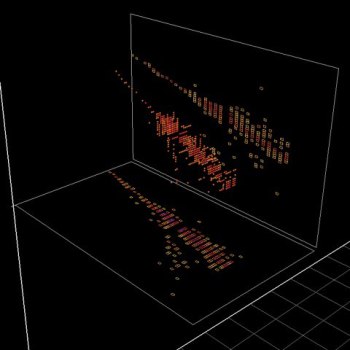Apr 5 2013
Taking data from cosmic rays for the first time and moving closer to the day later this year when physicists can begin measuring neutrino energies, the international NOvA experiment -- with the fingerprints of Indiana University researchers all over it -- began recording its first three-dimensional images last week.
 This image shows a cosmic-ray muon producing a large shower of energy as it passes through the NOvA far detector in Minnesota.
This image shows a cosmic-ray muon producing a large shower of energy as it passes through the NOvA far detector in Minnesota.
Neutrinos are still mysterious to scientists: They come in three flavors, or types, and mass states; oscillate, changing from one type to another; and are more abundant than cosmic rays, that constant rain of atomic nuclei that falls on earth from space. But what governs neutrino change -- what makes a muon neutrino oscillate into an electron neutrino -- is still a mystery that when solved could hold new clues to the origins of the universe.
"We're not measuring neutrinos yet, but this marks a milestone of the detector construction," said Mark Messier, a professor in the IU Bloomington College of Arts and Sciences' Department of Physics who also serves as spokesperson for NOvA. "We are now running all our systems end-to-end for the first time and can begin calibrating the instrument for the first beam from Fermilab in June."
Fermilab, which is America's premier national laboratory for particle physics research and is located outside of Chicago, will start sending a beam of neutrinos 500 miles through the earth to the NOvA detector under construction in Ash River, Minn. The NOvA detector is huge -- at 30 million pounds it's the world's largest PVC plastic structure -- and its 385,000 PVC cells are being filled with 2.8 million gallons of IU-crafted liquid scintillator, a material of mostly mineral oil and psuedocumene that becomes luminescent from ionized radiation.
When a neutrino interacts in the NOvA detector, the particles it produces leave trails of light in their wake. The detector records these streams of light, enabling physicists to identify the original neutrino and measure the amount of energy it had. IU's primary responsibility has been the optimization of the scintillator cost and performance, working out the mixing and delivery mechanism for the scintillating fluid, and understanding how to ensure uniform standards of production quality.
"I've basically spent a lot of time over the past decade inventing an industrial process to produce and transport liquid scintillator," said IU astronomy professor Stuart Mufson, whose research is tied to measuring neutrinos and anti-neutrinos. "Liquid scintillators were invented after World War II and used in different formulations in many high-energy physics experiments. However, none ever used nearly so much product. We developed the NOvA formula here and developed the ways to quality-control the product at production at a blender in Hammond, Ind., and at Ash River where it's delivered."
Mufson, who worked with Texas oil men and international chemical dealers, arranged for the shipment of mineral oil from the Gulf Coast and psuedocumene from China, while maintaining both quality and cost controls. He said 550,000 gallons have been blended to date and 400,000 gallons of that have been shipped to the NOvA site.
Neutrinos come in three varieties -- muon neutrinos, electron neutrinos and tau neutrinos -- and can morph from one to another through a process called oscillation. NOvA will measure one of these oscillations, muon to electron, using both neutrinos and anti-neutrinos -- a key first step in identifying the subatomic processes that took place right after the Big Bang, physicists believe.
"If the Big Bang created equal amounts of matter and antimatter, corresponding particles of matter and antimatter would meet and annihilate one another," Messier said. "But somehow we're still here, and antimatter, for the most part, has vanished."
Charge-parity symmetry theorizes that nothing would change about the laws of physics if every particle were replaced with its antiparticle, but it turns out that matter and antimatter are not mirror images, possibly explaining why they exist in unbalanced quantities. Breaking charge-parity symmetry is called CP violation, and to advance the theory that neutrinos tipped the balance between matter and antimatter, researches need to observe CP violation in action.
"By studying neutrino and antineutrino oscillation, we may be able to determine whether or not antineutrinos follow the same pattern as neutrinos when they change from one flavor to another. If they don't, that would be a signal of CP violation," Messier said. "The same mechanism that could cause neutrinos and antineutrinos to oscillate differently could have implications for the mechanism that would have led to an abundance of matter over antimatter in the early universe."
Other IU researchers who continue to work on the NOvA experiment, from liquid scintillator production to rapid feedback data acquisition systems, include IU physics professors James Musser and Jon Urheim, post-doctoral researchers Luke Corwin and Denver Whittington, graduate students Michael Baird and Evan Niner, IU physics technical staff Fritz Busch, Mark Gebhard, Brice Adams, Philip Childress, Brian Baugh and Rick Maloney, IU Cyclotron Facility engineers Gerard Visser and Walter Fox, and IU Department of Chemistry Mass Spectrometry Facility manager Jonathan A. Karty.
The $278 million NOvA experiment is an international collaboration of nearly 180 scientists and engineers from 34 universities, laboratories and institutions around the world, with the NOvA detector is under the operation of the University of Minnesota through a cooperative agreement with the U.S. Department of Energy's Office of Science. Scientists are funded by the U.S. Department of Energy, the National Science Foundation and funding agencies in the Czech Republic, Greece, India, Russia and the United Kingdom.